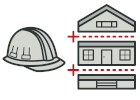
C++ 生成器模式讲解和代码示例
生成器是一种创建型设计模式, 使你能够分步骤创建复杂对象。
与其他创建型模式不同, 生成器不要求产品拥有通用接口。 这使得用相同的创建过程生成不同的产品成为可能。
复杂度:
流行度:
使用示例: 生成器模式是 C++ 世界中的一个著名模式。 当你需要创建一个可能有许多配置选项的对象时, 该模式会特别有用。
识别方法: 生成器模式可以通过类来识别, 它拥有一个构建方法和多个配置结果对象的方法。 生成器方法通常支持方法链 (例如 someBuilder->setValueA(1)->setValueB(2)->create())。
概念示例
本例说明了生成器设计模式的结构并重点回答了下面的问题:
- 它由哪些类组成?
- 这些类扮演了哪些角色?
- 模式中的各个元素会以何种方式相互关联?
main.cc: 概念示例
/**
* It makes sense to use the Builder pattern only when your products are quite
* complex and require extensive configuration.
*
* Unlike in other creational patterns, different concrete builders can produce
* unrelated products. In other words, results of various builders may not
* always follow the same interface.
*/
class Product1{
public:
std::vector<std::string> parts_;
void ListParts()const{
std::cout << "Product parts: ";
for (size_t i=0;i<parts_.size();i++){
if(parts_[i]== parts_.back()){
std::cout << parts_[i];
}else{
std::cout << parts_[i] << ", ";
}
}
std::cout << "\n\n";
}
};
/**
* The Builder interface specifies methods for creating the different parts of
* the Product objects.
*/
class Builder{
public:
virtual ~Builder(){}
virtual void ProducePartA() const =0;
virtual void ProducePartB() const =0;
virtual void ProducePartC() const =0;
};
/**
* The Concrete Builder classes follow the Builder interface and provide
* specific implementations of the building steps. Your program may have several
* variations of Builders, implemented differently.
*/
class ConcreteBuilder1 : public Builder{
private:
Product1* product;
/**
* A fresh builder instance should contain a blank product object, which is
* used in further assembly.
*/
public:
ConcreteBuilder1(){
this->Reset();
}
~ConcreteBuilder1(){
delete product;
}
void Reset(){
this->product= new Product1();
}
/**
* All production steps work with the same product instance.
*/
void ProducePartA()const override{
this->product->parts_.push_back("PartA1");
}
void ProducePartB()const override{
this->product->parts_.push_back("PartB1");
}
void ProducePartC()const override{
this->product->parts_.push_back("PartC1");
}
/**
* Concrete Builders are supposed to provide their own methods for
* retrieving results. That's because various types of builders may create
* entirely different products that don't follow the same interface.
* Therefore, such methods cannot be declared in the base Builder interface
* (at least in a statically typed programming language). Note that PHP is a
* dynamically typed language and this method CAN be in the base interface.
* However, we won't declare it there for the sake of clarity.
*
* Usually, after returning the end result to the client, a builder instance
* is expected to be ready to start producing another product. That's why
* it's a usual practice to call the reset method at the end of the
* `getProduct` method body. However, this behavior is not mandatory, and
* you can make your builders wait for an explicit reset call from the
* client code before disposing of the previous result.
*/
/**
* Please be careful here with the memory ownership. Once you call
* GetProduct the user of this function is responsable to release this
* memory. Here could be a better option to use smart pointers to avoid
* memory leaks
*/
Product1* GetProduct() {
Product1* result= this->product;
this->Reset();
return result;
}
};
/**
* The Director is only responsible for executing the building steps in a
* particular sequence. It is helpful when producing products according to a
* specific order or configuration. Strictly speaking, the Director class is
* optional, since the client can control builders directly.
*/
class Director{
/**
* @var Builder
*/
private:
Builder* builder;
/**
* The Director works with any builder instance that the client code passes
* to it. This way, the client code may alter the final type of the newly
* assembled product.
*/
public:
void set_builder(Builder* builder){
this->builder=builder;
}
/**
* The Director can construct several product variations using the same
* building steps.
*/
void BuildMinimalViableProduct(){
this->builder->ProducePartA();
}
void BuildFullFeaturedProduct(){
this->builder->ProducePartA();
this->builder->ProducePartB();
this->builder->ProducePartC();
}
};
/**
* The client code creates a builder object, passes it to the director and then
* initiates the construction process. The end result is retrieved from the
* builder object.
*/
/**
* I used raw pointers for simplicity however you may prefer to use smart
* pointers here
*/
void ClientCode(Director& director)
{
ConcreteBuilder1* builder = new ConcreteBuilder1();
director.set_builder(builder);
std::cout << "Standard basic product:\n";
director.BuildMinimalViableProduct();
Product1* p= builder->GetProduct();
p->ListParts();
delete p;
std::cout << "Standard full featured product:\n";
director.BuildFullFeaturedProduct();
p= builder->GetProduct();
p->ListParts();
delete p;
// Remember, the Builder pattern can be used without a Director class.
std::cout << "Custom product:\n";
builder->ProducePartA();
builder->ProducePartC();
p=builder->GetProduct();
p->ListParts();
delete p;
delete builder;
}
int main(){
Director* director= new Director();
ClientCode(*director);
delete director;
return 0;
}
Output.txt: 执行结果
Standard basic product:
Product parts: PartA1
Standard full featured product:
Product parts: PartA1, PartB1, PartC1
Custom product:
Product parts: PartA1, PartC1
 冬季促销!
冬季促销!
